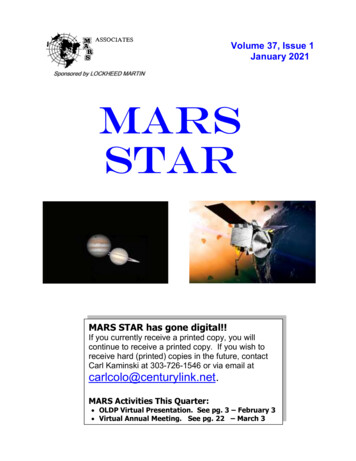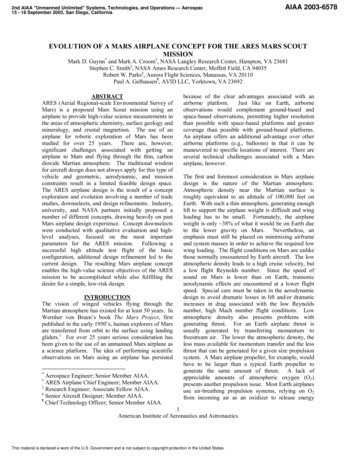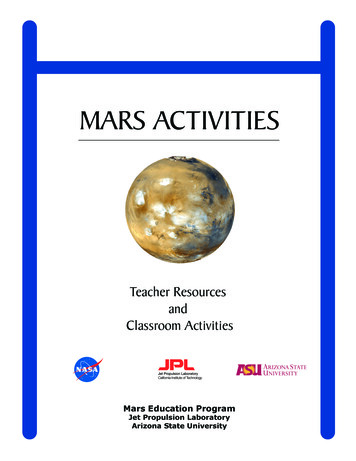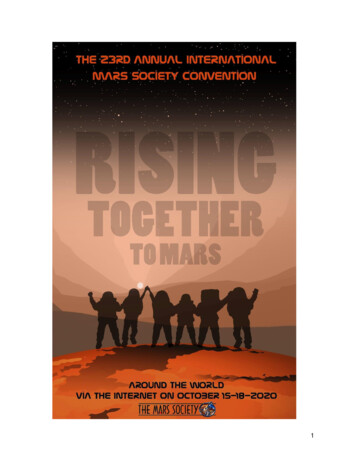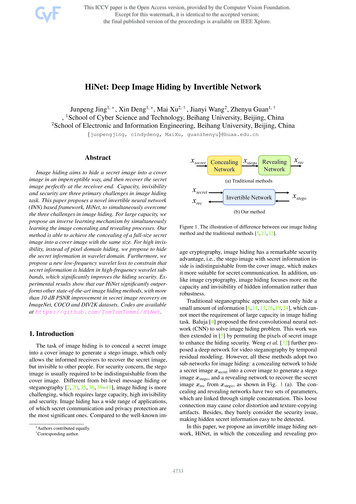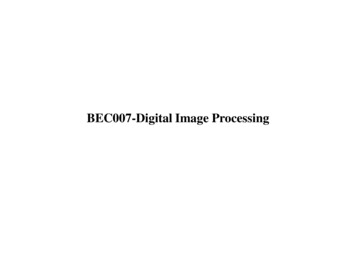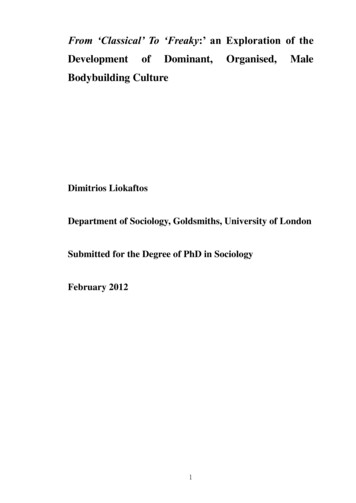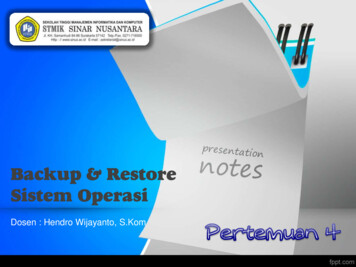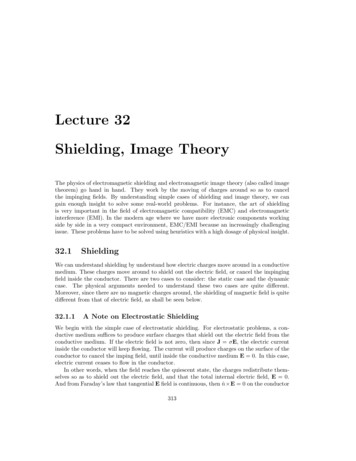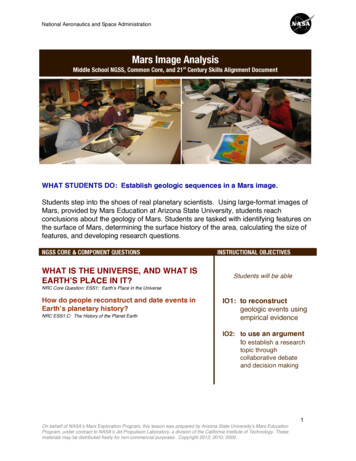
Transcription
National Aeronautics and Space AdministrationMars Image AnalysisMiddle School NGSS, Common Core, and 21st Century Skills Alignment DocumentWHAT STUDENTS DO: Establish geologic sequences in a Mars image.Students step into the shoes of real planetary scientists. Using large-format images ofMars, provided by Mars Education at Arizona State University, students reachconclusions about the geology of Mars. Students are tasked with identifying features onthe surface of Mars, determining the surface history of the area, calculating the size offeatures, and developing research questions.NGSS CORE & COMPONENT QUESTIONSWHAT IS THE UNIVERSE, AND WHAT ISEARTH’S PLACE IN IT?INSTRUCTIONAL OBJECTIVESStudents will be ableNRC Core Question: ESS1: Earth’s Place in the UniverseHow do people reconstruct and date events inEarth’s planetary history?NRC ESS1.C: The History of the Planet EarthIO1: to reconstructgeologic events usingempirical evidenceIO2: to use an argumentto establish a researchtopic throughcollaborative debateand decision making1On behalf of NASA’s Mars Exploration Program, this lesson was prepared by Arizona State University’s Mars EducationProgram, under contract to NASA’s Jet Propulsion Laboratory, a division of the California Institute of Technology. Thesematerials may be distributed freely for non-commercial purposes. Copyright 2012; 2010; 2000.
National Aeronautics and Space Administration1.0 About This ActivityMars lessons leverage A Taxonomy for Learning, Teaching, and Assessing by Anderson andKrathwohl (2001) (see Section 4 and Teacher Guide at the end of this document). Thistaxonomy provides a framework to help organize and align learning objectives, activities, andassessments. The taxonomy has two dimensions. The first dimension, cognitive process,provides categories for classifying lesson objectives along a continuum, at increasingly higherlevels of thinking; these verbs allow educators to align their instructional objectives andassessments of learning outcomes to an appropriate level in the framework in order to build andsupport student cognitive processes. The second dimension, knowledge, allows educators toplace objectives along a scale from concrete to abstract. By employing Anderson andKrathwohl’s (2001) taxonomy, educators can better understand the construction of instructionalobjectives and learning outcomes in terms of the types of student knowledge and cognitiveprocesses they intend to support. All activities provide a mapping to this taxonomy in theTeacher Guide (at the end of this lesson), which carries additional educator resources.Combined with the aforementioned taxonomy, the lesson design also draws upon Miller, Linn,and Gronlund’s (2009) methods for (a) constructing a general, overarching, instructionalobjective with specific, supporting, and measurable learning outcomes that help assure theinstructional objective is met, and (b) appropriately assessing student performance in theintended learning-outcome areas through rubrics and other measures.How Students Learn: Science in the Classroom (Donovan & Bransford, 2005) advocates theuse of a research-based instructional model for improving students’ grasp of central scienceconcepts. Based on conceptual-change theory in science education, the 5E Instructional Model(BSCS, 2006) includes five steps for teaching and learning: Engage, Explore, Explain,Elaborate, and Evaluate. The Engage stage is used like a traditional warm-up to pique studentcuriosity, interest, and other motivation-related behaviors and to assess students’ priorknowledge. The Explore step allows students to deepen their understanding and challengesexisting preconceptions and misconceptions, offering alternative explanations that help themform new schemata. In Explain, students communicate what they have learned, illustratinginitial conceptual change. The Elaborate phase gives students the opportunity to apply theirnewfound knowledge to novel situations and supports the reinforcement of new schemata or itstransfer. Finally, the Evaluate stage serves as a time for students’ own formative assessment,as well as for educators’ diagnosis of areas of confusion and differentiation of further instruction.The 5E stages can be cyclical and iterative.2On behalf of NASA’s Mars Exploration Program, this lesson was prepared by Arizona State University’s Mars EducationProgram, under contract to NASA’s Jet Propulsion Laboratory, a division of the California Institute of Technology. Thesematerials may be distributed freely for non-commercial purposes. Copyright 2012; 2010; 2000.
National Aeronautics and Space Administration2.0 Instructional Objectives, Learning Outcomes, & StandardsInstructional objectives and learning outcomes are aligned with National Research Council’s, A Framework for K-12 Science Education: Practices,Crosscutting Concepts, and Core Ideas Achieve Inc.’s, Next Generation Science Standards (NGSS) National Governors Association Center for Best Practices (NGA Center) and Council ofChief State School Officers (CCSSO)’s, Common Core State Standards for EnglishLanguage Arts & Literacy in History/Social Studies, Science, and Technical Subjects Partnership for 21st Century Skills, A Framework for 21st Century LearningThe following chart provides details on alignment among the core and component NGSSquestions, instructional objectives, learning outcomes, and educational standards. Your instructional objectives (IO) for this lesson align with the NGSS Framework andNGSS. You will know that you have achieved these instructional objectives if studentsdemonstrate the related learning outcomes (LO). You will know the level to which your students have achieved the learning outcomes byusing the suggested rubrics (see Teacher Guide at the end of this lesson).Quick View of Standards Alignment:The Teacher Guide at the end of this lesson provides full details of standards alignment, rubrics,and the way in which instructional objectives, learning outcomes, 5E activity procedures, andassessments were derived through, and align with, Anderson and Krathwohl’s (2001) taxonomyof knowledge and cognitive process types. For convenience, a quick view follows:3On behalf of NASA’s Mars Exploration Program, this lesson was prepared by Arizona State University’s Mars EducationProgram, under contract to NASA’s Jet Propulsion Laboratory, a division of the California Institute of Technology. Thesematerials may be distributed freely for non-commercial purposes. Copyright 2012; 2010; 2000.
National Aeronautics and Space AdministrationWHAT IS THE UNIVERSE, AND WHAT IS EARTH’S PLACE IN IT?NRC Core Question: ESS1: Earth’s Place in the UniverseHow do people reconstruct and date events in Earth’s planetary history?NRC ESS1.C: The History of the Planet EarthInstructional ObjectiveStudents will be ableIO1: toreconstructgeologic eventsusing empiricalevidenceLearning OutcomesStudents will demonstrate themeasurable abilitiesLO1a. to identifygeologicfeatures in aTHEMIS imageLO1b. to sequencegeologicfeatures usingrelative datingprinciplesLO1c. to explain howthe sequence ofgeologicfeatures weredeterminedIO2: to use anargument toestablish aresearch topicthroughcollaborativedebate anddecision makingLO2a. to use claim,evidence, andreasoning inobservationsLO1b. to generatebackgroundresearch fromcredible sourcesLO1c. to collaborateas a team overpotential topicsusing claim,evidence, andreasoningStandardsStudents will addressNSES: UNIFYING CONCEPTS & PROCESSES:K-12: Evidence, models, andexplanationsNSES (D): EARTH AND SPACE SCIENCE:Structure of the Earth SystemGrades 5-8: D1c, D1dEarth’s HistoryGrades 5-8: D2aNGSS Disciplinary Core Idea:ESS1.C: The History of Planet Earth(MS-ESS1-4)NGSS Practices:Asking Questions and Defining Problems:(Grades 6-8)Using Mathematics and ComputationalThinking (Grades 6-8)Constructing Explanations and DesigningSolutions: (Grades 6-8)Obtaining, Evaluating, and CommunicatingInformation (Grades 6-8)Engaging in Argument from Evidence(Grades 6-8)NGSS Cross-Cutting Concept:Patterns (Grades 6-8)Cause and Effect: Mechanism andPrediction (Grades 6-8)Scale, Proportion and Quantity (Grades 6-8)4On behalf of NASA’s Mars Exploration Program, this lesson was prepared by Arizona State University’s Mars EducationProgram, under contract to NASA’s Jet Propulsion Laboratory, a division of the California Institute of Technology. Thesematerials may be distributed freely for non-commercial purposes. Copyright 2012; 2010; 2000.
National Aeronautics and Space Administration3.0 Learning Outcomes, NGSS, Common Core, & 21st Century Skills ConnectionsThe connections diagram is used to organize the learning outcomes addressed in the lesson toestablish where each will meet the Next Generation Science Standards, ELA and MathCommon Core Standards, and the 21st Century Skills and visually determine where there areoverlaps in these documents.Next GenerationScience StandardsCommon CoreLO1a: to identify geologicfeatures in a THEMIS imagerequiring a technologicaldesignLO1c: to explain how the sequencefeatures was determinedof geologicLO2a: to use claim, evidence, andreasoning in observationsLO2b: to generate backgroundresearch from credible sourcesLO2c: to collaborate as a teamover potential topics using claim,evidence, and reasoningLO1b: to sequencegeologic featuresusing relative datingprinciplesThe Partnership forst21 Century Skills5On behalf of NASA’s Mars Exploration Program, this lesson was prepared by Arizona State University’s Mars EducationProgram, under contract to NASA’s Jet Propulsion Laboratory, a division of the California Institute of Technology. Thesematerials may be distributed freely for non-commercial purposes. Copyright 2012; 2010; 2000.
National Aeronautics and Space Administration4.0 Evaluation/AssessmentRubric: A rubric has been provided to assess student understanding of the simulation andto assess metacognition. A copy has been provided in the Student Guide for students toreference prior to the simulation. This rubric will allow them to understand the expectationsset before them.5.0 ReferencesAchieve, Inc. (2013). Next generation science standards. Achieve, Inc. on behalf of the twentysix states and partners that collaborated on the NGSS.Anderson, L.W., & Krathwohl (Eds.). (2001). A taxonomy for learning, teaching, and assessing:A revision of Bloom's taxonomy of educational objectives. New York: Longman.Bybee, R., Taylor, J., Gardner, A., Van Scotter, P., Carson Powell, J., Westbrook, A., Landes,N. (2006) The BSCS 5E instructional model: origins, effectiveness, and applications.Colorado Springs: BSCS.Donovan, S. & Bransford, J. D. (2005). How Students Learn: History, Mathematics, and Sciencein the Classroom. Washington, DC: The National Academies Press.Miller, Linn, & Gronlund. (2009). Measurement and assessment in teaching. Upper SaddleRiver, NJ: Pearson.National Academies Press. (1996, January 1). National science education standards. RetrievedFebruary 7, 2011 from http://www.nap.edu/catalog.php?record id 4962National Governors Association Center for Best Practices & Council of Chief State SchoolOfficers. (2010). Common Core State Standards. Washington, DC: Authors.National Research Council. (2012). A framework for K-12 science education: Practices,crosscutting concepts, and core ideas. Committee on a Conceptual Framework for NewK-12 Science Education Standards. Board on Science Education, Division of Behavioraland Social Sciences and Education. Washington, DC: The National Academies Press.The Partnership for 21st Century Skills (2011). A framework for 21st centurylearning. Retrieved March 15, 2012 from http://www.p21.org6On behalf of NASA’s Mars Exploration Program, this lesson was prepared by Arizona State University’s Mars EducationProgram, under contract to NASA’s Jet Propulsion Laboratory, a division of the California Institute of Technology. Thesematerials may be distributed freely for non-commercial purposes. Copyright 2012; 2010; 2000.
National Aeronautics and Space AdministrationMARS IMAGE ANALYSISTeacher Guide(L) Teacher Resource. Mars Image Analysis Rubric (1 of 3)You will know the level to which your students have achieved the Learning Outcomes,and thus the Instructional Objective(s), by using the suggested Rubrics below.Instructional Objective 1: to reconstruct geologic events using empiricalevidenceInstructional Objective 2: to use an argument to establish a research topicthrough collaborative debate and decision makingRelated Standard(s)National Science Education Standards (NSES)UNIFYING CONCEPTS & PROCESSESGrades K-12: Evidence, models, and explanationsEvidence consists of observations and data on which to base scientific explanations.Using evidence to understand interactions allows individuals to predict changes innatural and designed systems. Models are tentative schemes or structures thatcorrespond to real objects, events, or classes of events, and that have explanatorypower. Models help scientists and engineers understand how things work. Models takemany forms, including physical objects, plans, mental constructs, mathematicalequations, and computer simulations.Scientific explanations incorporate existing scientific knowledge and new evidence fromobservations, experiments, or models into internally consistent, logical statements.Different terms, such as “hypothesis,” “model,” “law,” “principle,” “theory,” and“paradigm” are used to describe various types of scientific explanations.As students develop and as they understand more science concepts and processes,their explanations should become more sophisticated. That is, their scientificexplanations should more frequently include a rich scientific knowledge base, evidenceof logic, higher levels of analysis, greater tolerance of criticism and uncertainty, and aclearer demonstration of the relationship between logic, evidence, and currentknowledge.National Science Education Standards (NSES)(A) Science as Inquiry: Understandings about Scientific InquiryDifferent kinds of questions suggest different kinds of scientific investigations. Someinvestigations involve observing and describing objects, organisms, or events; someinvolve collecting specimens; some involve experiments; some involve seeking more7On behalf of NASA’s Mars Exploration Program, this lesson was prepared by Arizona State University’s Mars EducationProgram, under contract to NASA’s Jet Propulsion Laboratory, a division of the California Institute of Technology. Thesematerials may be distributed freely for non-commercial purposes. Copyright 2012; 2010; 2000.
National Aeronautics and Space Administrationinformation; some involve discovery of new objects and phenomena; and some involvemaking models (Grades 5-8: A2a).National Science Education Standards (NSES)(A) Science as Inquiry: Abilities Necessary to Do Scientific InquiryThink critically and logically to make the relationship between evidence andexplanations (Grades 5-8: A1e).National Science Education Standards (NSES)(D) Earth and Space Science: Structure of the Earth SystemLandforms are the result of a combination of constructive and destructive forces.Constructive forces include crustal deformation, volcanic eruption, and depositions ofsediment, while destructive forces include weathering and erosion (Grades 5-8: D1c).Some changes in the solid earth can be describes as the “rock cycle.” Old rocks at theEarth’s surface weather, forming sediments that are buried, then compacted, heated,and often recrystallized into new rock. Eventually, those new rocks may be brought tothe surface by the forces that drive plate motions, and the rock cycle continues (Grades5-8: D1d).National Science Education Standards (NSES)(D) Earth and Space Science: Earth’s HistoryThe earth process we see today, including erosion, movement of lithospheric plates,and changes in atmospheric composition, are similar to those that occurred in the past.Earth history is also influenced by occasional catastrophes, such as the impact of anasteroid or comet (Grades 5-8: D2a).*This lesson supports the preparation of students toward achieving NGSS PerformanceExpectations using the Practices, Cross-Cutting Concepts and Disciplinary Core Ideasdefined below:(MS-ESS1-4)Next Generation Science Standards (NGSS)Practices: Asking Questions and Defining Problems(Learning Outcomes Addressed: LO2a, LO2b, LO2c) Ask questions that arise from careful observation of phenomena, models, or unexpectedresults, to clarify and/or seek additional information. to identify and/or clarify evidence and/or the premise(s) of an argument. that challenge the premise(s) of an argument or the interpretation of a dataset.8On behalf of NASA’s Mars Exploration Program, this lesson was prepared by Arizona State University’s Mars EducationProgram, under contract to NASA’s Jet Propulsion Laboratory, a division of the California Institute of Technology. Thesematerials may be distributed freely for non-commercial purposes. Copyright 2012; 2010; 2000.
National Aeronautics and Space AdministrationNext Generation Science Standards (NGSS)Practices: Using Mathematics and Computational Thinking(Learning Outcomes Addressed: LO1a) Apply mathematical concepts and/or processes (e.g., ratio, rate, percent, basicoperations, simple algebra) to scientific and engineering questions and problems.Next Generation Science Standards (NGSS)Practices: Constructing Explanations and Designing Solutions(Learning Outcomes Addressed: LO1a, LO1c, LO2a, LO2b, LO2c) Construct an explanation that includes qualitative or quantitative relationshipsbetween variables that predict(s) and/or describe(s) phenomena. Construct a scientific explanation based on valid and reliable evidence obtainedfrom sources (including the students’ own experiments) and the assumption thattheories and laws that describe the natural world operate today as they did in thepast and will continue to do so in the future. Apply scientific ideas, principles, and/or evidence to construct, revise and/or usean explanation for real-world phenomena, examples, or events. Apply scientific reasoning to show why the data or evidence is adequate for theexplanation or conclusion.Next Generation Science Standards (NGSS)Practices: Engaging in Argument from Evidence(Learning Outcomes Addressed: LO1a, LO1c, LO2a, LO2b, LO2c) Compare and critique two arguments on the same topic and analyze whetherthey emphasize similar or different evidence and/or interpretations of facts. Respectfully provide and receive critiques about one’s explanations, procedures,models, and questions by citing relevant evidence and posing and responding toquestions that elicit pertinent elaboration and detail. Construct, use, and/or present an oral and written argument supported byempirical evidence and scientific reasoning to support or refute an explanation ora model for a phenomenon or a solution to a problem. Make an oral or written argument that supports or refutes the advertisedperformance of a device, process, or system based on empirical evidenceconcerning whether or not the technology meets relevant criteria and constraints.9On behalf of NASA’s Mars Exploration Program, this lesson was prepared by Arizona State University’s Mars EducationProgram, under contract to NASA’s Jet Propulsion Laboratory, a division of the California Institute of Technology. Thesematerials may be distributed freely for non-commercial purposes. Copyright 2012; 2010; 2000.
National Aeronautics and Space AdministrationNext Generation Science Standards (NGSS)Practices: Obtaining, Evaluating, and Communicating Information(Learning Outcomes Addressed: LO1a, LO1c, LO2a, LO2b, LO2c) Critically read scientific texts adapted for classroom use to determine the centralideas and/or obtain scientific and/or technical information to describe patterns inand/or evidence about the natural and designed world(s). Integrate qualitative and/or quantitative scientific and/or technical information inwritten text with that contained in media and visual displays to clarify claims andfindings. Gather, read, and synthesize information from multiple appropriate sources andassess the credibility, accuracy, and possible bias of each publication andmethods used, and describe how they are supported or not supported byevidence. Communicate scientific and/or technical information (e.g. about a proposedobject, tool, process, system) in writing and/or through oral presentations.Next Generation Science Standards (NGSS)Cross-Cutting Concepts: Patterns(Learning Outcomes Addressed: LO1a, LO1c, LO2a, LO2b, LO2c) Students recognize that macroscopic patterns are related to the nature ofmicroscopic and atomic-level structure. They identify patterns in rates of changeand other numerical relationships that provide information about natural andhuman designed systems. They use patterns to identify cause and effectrelationships, and use graphs and charts to identify patterns in data.Next Generation Science Standards (NGSS)Cross-Cutting Concepts: Cause and Effect: Mechanism and Prediction(Learning Outcomes Addressed: LO1a, LO1c, LO2a, LO2b, LO2c) Students classify relationships as causal or correlational, and recognize thatcorrelation does not necessarily imply causation. They use cause and effectrelationships to predict phenomena in natural or designed systems. They alsounderstand that phenomena may have more than one cause, and some causeand effect relationships in systems can only be described using probability.Next Generation Science Standards (NGSS)Cross-Cutting Concepts: Scale, Proportion, and Quantity(Learning Outcomes Addressed: LO1a, LO1c, LO2a, LO2b, LO2c)10On behalf of NASA’s Mars Exploration Program, this lesson was prepared by Arizona State University’s Mars EducationProgram, under contract to NASA’s Jet Propulsion Laboratory, a division of the California Institute of Technology. Thesematerials may be distributed freely for non-commercial purposes. Copyright 2012; 2010; 2000.
National Aeronautics and Space Administration Students observe time, space, and energy phenomena at various scales usingmodels to study systems that are too large or too small. They understandphenomena observed at one scale may not be observable at another scale, andthe function of natural and designed systems may change with scale. They useproportional relationships (e.g., speed as the ratio of distance traveled to timetaken) to gather information about the magnitude of properties and processes.They represent scientific relationships through the use of algebraic expressionsand equations.Next Generation Science Standards (NGSS)Disciplinary Core Idea: ESS1.C: The History of Planet Earth(Learning Outcomes Addressed: LO1a, LO1b, LO1c) The geologic time scale interpreted from rock strata provides a way to organizeEarth’s history. Analyses of rock strata and the fossil record provide only relativedates, not an absolute scale.Common Core State StandardsReading for Informational Text Standards 5: Key Ideas and Details(Learning Outcomes Addressed: LO2b) Quote accurately from a text when explaining what the text says explicitly andwhen drawing inferences from the text. Determine two or more main ideas of a text and explain how they are supportedby key details; summarize the text. Explain the relationships or interactions between two or more individuals, events,ideas, or concepts in a historical, scientific, or technical text based on specificinformation in the text.Common Core State StandardsReading for Informational Text Standards 5: Craft and Structure(Learning Outcomes Addressed: LO1a, LO2a, LO2b, LO2c) Determine the meaning of general academic and domain-specific words andphrases in a text relevant to a grade 5 topic or subject area.Common Core State StandardsReading for Informational Text Standards 5: Integration of Knowledge andIdeas(Learning Outcomes Addressed: LO2a, LO2b, LO2c)11On behalf of NASA’s Mars Exploration Program, this lesson was prepared by Arizona State University’s Mars EducationProgram, under contract to NASA’s Jet Propulsion Laboratory, a division of the California Institute of Technology. Thesematerials may be distributed freely for non-commercial purposes. Copyright 2012; 2010; 2000.
National Aeronautics and Space Administration Explain how specific images (e.g., a diagram showing how a machine works)contribute to and clarify a text. Compare and contrast the most important points presented by two texts on thesame topic.Common Core State StandardsReading for Literacy in Science and Technical Subjects Standards 6-8: KeyIdeas and Details(Learning Outcomes Addressed: LO1c, LO2a, LO2b, LO2c) Cite specific textual evidence to support analysis of science and technical texts. Determine the central ideas or conclusions of a text; provide an accuratesummary of the text distinct from prior knowledge or opinions. Follow precisely a multistep procedure when carrying out experiments, takingmeasurements, or performing technical tasks.Common Core State StandardsReading for Literacy in Science and Technical Subjects Standards 6-8:Craft and Structure(Learning Outcomes Addressed: LO1a, LO2a, LO2b) Determine the meaning of symbols, key terms, and other domain-specific wordsand phrases as they are used in a specific scientific or technical context relevantto grades 6–8 texts and topics.Common Core State StandardsReading for Literacy in Science and Technical Subjects Standards 6-8:Integration of Knowledge and Ideas(Learning Outcomes Addressed: LO2a, LO2b, LO2c) Integrate quantitative or technical information expressed in words in a text with aversion of that information expressed visually (e.g., in a flowchart, diagram,model, graph, or table). Compare and contrast the information gained from experiments, simulations,video, or multimedia sources with that gained from reading a text on the sametopic.Common Core State StandardsWriting Standards 5: Research to Build and Present Knowledge(Learning Outcomes Addressed: LO2a, LO2b, LO2c)12On behalf of NASA’s Mars Exploration Program, this lesson was prepared by Arizona State University’s Mars EducationProgram, under contract to NASA’s Jet Propulsion Laboratory, a division of the California Institute of Technology. Thesematerials may be distributed freely for non-commercial purposes. Copyright 2012; 2010; 2000.
National Aeronautics and Space Administration Conduct short research projects that use several sources to build knowledgethrough investigation of different aspects of a topic. Recall relevant information from experiences or gather relevant information fromprint and digital sources; summarize or paraphrase information in notes andfinished work, and provide a list of sources. Draw evidence from literary or informational texts to support analysis, reflection,and research. Apply grade 5 Reading standards to informational texts (e.g., “Explain how anauthor uses reasons and evidence to support particular points in a text,identifying which reasons and evidence support which point[s]”).Common Core State StandardsWriting for Literacy in Science and Technical Subjects Standards 6-8:Research to Build and Present Knowledge(Learning Outcomes Addressed: LO2b) Conduct short research projects to answer a question (including a self-generatedquestion), drawing on several sources and generating additional related, focusedquestions that allow for multiple avenues of exploration. Gather relevant information from multiple print and digital sources, using searchterms effectively; assess the credibility and accuracy of each source; and quoteor paraphrase the data and conclusions of others while avoiding plagiarism andfollowing a standard format for citation. Draw evidence from informational texts to support analysis reflection, andresearch.Common Core State StandardsWriting Standards 6-8: Production and Distribution of Writing(Learning Outcomes Addressed: LO1a, LO1d, LO1e) Produce clear and coherent writing in which the development and organizationare appropriate to task, purpose, and audience.Common Core State StandardsWriting Standards 6-8: Research to Build and Present Knowledge(Learning Outcomes Addressed: LO1a, LO1d, LO1e)13On behalf of NASA’s Mars Exploration Program, this lesson was prepared by Arizona State University’s Mars EducationProgram, under contract to NASA’s Jet Propulsion Laboratory, a division of the California Institute of Technology. Thesematerials may be distributed freely for non-commercial purposes. Copyright 2012; 2010; 2000.
National Aeronautics and Space Administration Recall relevant information from experiences or gather relevant information fromprint and digital sources; summarize or paraphrase information in notes andfinished work, and provide a list of sources. Draw evidence from literary or informational texts to support analysis, reflection,and research.Common Core State StandardsSpeaking and Listening 5: Comprehension and Collaboration(Learning Outcomes Addressed: LO1c, LO2c) Engage effectively in a range of collaborative discussions (one-on-one, in groups,and teacher-led) with diverse partners on grade 5 topics and texts, building onothers’ ideas and expressing their own clearly. Come to discussions prepared, having read or studied required material;explicitly draw on that preparation and other information known about the topic toexplore ideas under discussion. Pose and respond to specific questions by making comments that contribute tothe discussion and elaborate on the remarks of others. Review the key ideas expressed and draw conclusions in light of information andknowledge gained from the discussions.Common Core State StandardsMath 5: Numbers and Operation in Base Ten (5.NBT.7)(Learning Outcomes Addressed: LO1a) Add, subtract, multiply, and divide decimals to hundredths, using concretemodels or drawings and strategies based on place value, properties ofoperations, and/or the relationship between addition and subtraction; relate thestrategy to a written method and explain the reasoning used.C
National Research Council. (2012). A framework for K-12 science education: Practices, crosscutting concepts, and core ideas. Committee on a Conceptual Framework for New K-12 Science Education Standards. Board on Science Education, Division of Behavioral and Social Sciences and Education. Washi
